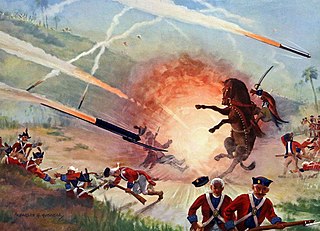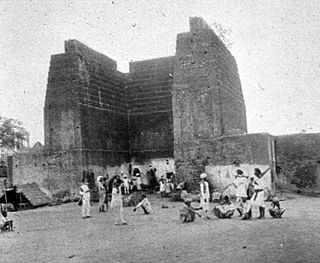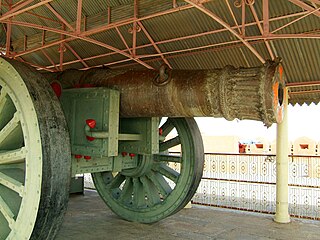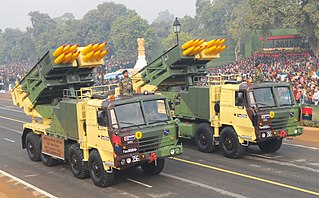 W
WThe 105 mm Light Field Gun was designed by the Armament Research and Development Establishment, or ARDE, in 1972. It is a towed variant of the British L13 105mm howitzer as mounted on the FV433 Abbot.
 W
WBacchawali Tope is a cannon which lies in the Nizamat Fort Campus on the garden space between the Nizamat Imambara and the Hazarduari Palace and to the east of the old Madina Mosque in the city of Murshidabad in the Indian state of West Bengal. The cannon consists two pieces of different diameters. The cannon was made between the 12th and 14th century, probably by the Mohammeddan rulers of Gaur. It originally lied on the sand banks of Ichaganj. However, it is unknown that how it came in Ichaganj. It was used to protect the city of Murshidabad from north-western attacks. After the 1846 fire of the Nizamat Imambara the Imambara was rebuilt, then after the completion of the new Imambara the cannon was shifted to its present site by Sadeq Ali Khan, the architect of the sacred Nizamat Imambara under the suggestion of Sir Henry Torrens, the then agent of the Governor General at Murshidabad.
 W
WBell metal is a hard bronze alloy used for making bells and related instruments, such as cymbals. It is a form of bronze with a higher tin content, usually in approximately a 4:1 ratio of copper to tin. The higher tin content increases the rigidity of the metal, and increases the resonance. It also has industrial uses, being specified for valve bodies, piston rings, bearings, and bushings.
 W
WThe Bharat-52 gun is a 155mm, 52 caliber towed howitzer manufactured by Bharat Forge, a subsidiary of Kalyani Group.
 W
WThe Bijapur Fort is located in the Bijapur city in Bijapur District of the Indian state of Karnataka. Bijapur fort has a plethora of historical monuments of architectural importance built during the rule of Adil Shahi dynasty.
 W
WHambir Malla Dev, also known as Bir Hambir & Veer Hambir, was the forty-ninth king of the Mallabhum. He is notable for his military resistance against the expansionism of the Pathans and was known for his participation in the Battle of Mundamala Ghat. He ruled from 1565 to 1620 CE.
 W
WThe Dhanush is a 155 mm towed howitzer used by the Indian Army. The gun was approved for service in 2019.
 W
WFathul Mujahidin is a military manual that was written by Zainul Abedin Shustari at the instruction of Tipu Sultan, the ruler of the Kingdom of Mysore in South India considered a pioneer in the use of rocket artillery. Mysore started to equip their army with rockets in the 1750s and during the Second Anglo–Mysore War (1780–1784) Tipu and his father Haider Ali used this technology against British troops. Tipu Sultan used rockets in battle with the British Army in the 1792 Siege of Srirangapatna, a battle at the end of the Third Anglo-Mysore War.
 W
WThe Gunfoundry also known as Top ka Sancha was a cannonball factory set up by the second Nizam of Hyderabad, Nawab Mir Nizam Ali Khan at Fateh Maidan in Hyderabad, India. The historic Aliya High School for Boys.
 W
WJahan Kosha Cannon literally means the Destroyer of the World. It is placed in the Topekhana a quarter of mile to the south east of the Katra Mosque, in the town of Murshidabad, West Bengal, India. Topekhana was the Nawab's Artillery Park and the entrance gate of the old capital of Bengal, Bihar and Orissa, the city of Jahangir Nagar. It is protected on the east by the Gobra Nala, locally known as the Katra Jheel. Here, the Jahan Kosha Cannon is laid to rest. Before being placed at its current location, it rested on a carriage with wheels and was surrounded by the roots of a Peepal tree. The growth of the tree roots gradually lifted the gun four feet above the ground. The wheels of the gun carriage have disappeared, but the iron-work of the carriage and the trunions are still visible. The cannon is made of ashtadhatu or 8 metals, namely silver, gold, lead, copper, zinc, tin, iron and mercury.
 W
WThe Jaivana Cannon is a large 18th-century cannon preserved at Jaigarh Fort, in Rajasthan, India. At the time of its manufacture in 1720, it was the world's largest cannon on wheels of the Early Modern Era.
 W
WThe M-46 Catapult was a self-propelled gun developed in India by Combat Vehicles Research & Development Establishment of the Defence Research & Development Organisation.
 W
WMughal artillery included a variety of cannons, rockets, and mines employed by the Mughal Empire. This gunpowder technology played an important role in the formation and expansion of the empire.
 W
WPinaka is a multiple rocket launcher produced in India and developed by the Defence Research and Development Organisation (DRDO) for the Indian Army. The system has a maximum range of 40 km for Mark-I and 60 km for Mark-I enhanced version, and can fire a salvo of 12 HE rockets in 44 seconds. The system is mounted on a Tatra truck for mobility. Pinaka saw service during the Kargil War, where it was successful in neutralising enemy positions on the mountain tops. It has since been inducted into the Indian Army in large numbers.
 W
WThe Thanjavur cannon is one of the largest early modern period cannons located in Thanjavur, Thanjavur district, Tamil Nadu, India.